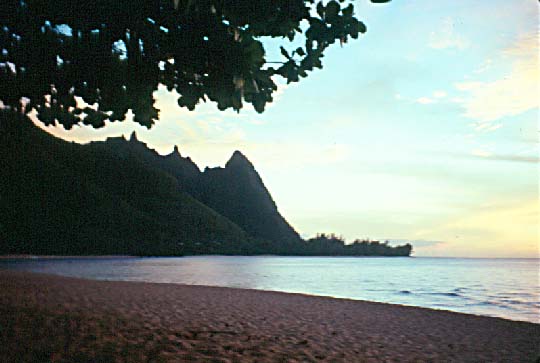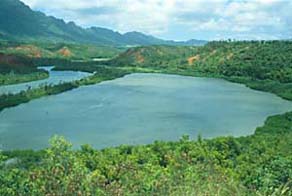 |
 |
 |
|||||
|
|
|
|
|
|
|
|
|
|
|
|||||||
|
|
|

Ke'e Beach, Makana and Mauna-pulu-o Mountains
|
|
At certain times of year, the winds and currents from Central Polynesia would take a boat past the Southern Hawaiian Islands and land it at Kaua'i and Ni'ihau. This is exactly what happened to Captain Cook, who first landed in the Hawaiian archipelago at these two islands. Ha‘ena has a very strong tradition of peoples living here before the "Hawaiians" of today. The most well known of these peoples go by the name "Menehune." While in popular culture in the Islands today these peoples have gained a mythological status, in Ha‘ena they form an important part of local historical tradition as well as legends and place names. But who were these people, and where did they come from?
|
||
|
|
||
The popular notion of the Menehune paints them as little people, similar to leprechauns. When and how this idea of the Menehune as small developed is uncertain, but it appears at least as far back as a 1908 local Hawaiian treatise on the subject. As Carlos tells it "the so-called 'king' of the Menehune tells his people he wants to get them all together and they're going to leave, because he doesn't like the idea of his, of the Menehune men folk, marrying Hawaiian women and having children with Hawaiian women, which apparently they were doing in enough numbers to alarm him. At the same time, the Menehune are described as being between two and a half to three feet tall. Now, how are men two and a half and three feet tall--all these dwarves--going to marry regular Hawaiian women in such numbers? Why are these Hawaiian women marrying all these dwarves? So, that's a question that remains unresolved. But there's a Tahitian reference to Manahune, which seems to say that 'manahune' is a name given to people of a low social status, rather than low physical stature."
|
||
|
|
||
According to Joesting (1984:20-1) the Tahitians had once been known in their homeland as Manahune, a slight dialectical variation of Menehune: "They bore the name with honor until Tahiti was conquered by warriors from Raiatea, when it took on a very different meaning. Manahune became the name for a commoner and a term of derision. In the Hawaiian Islands, seizing the positions of leadership, the Tahitians labeled the original settlers Menehune, a repetition of what the Raiateans had done to them. "The following Tahitian mele is in disdain of the Manahune. Go to the mountains where you belong,
|
||
|
|
||
|
"The Marquesans had no such word as Manahune in their vocabulary. In the Marquesas the word for commoner was maka ‘ainana, which became the accepted word in Hawaii for a commoner, or a person who tended to land." The combination of low social stature (or physical height) with living back in the mountains that this Tahitian mele suggests, also appears in the case of the Menehune of Kaua‘i. The census takers of Kaumulai‘i, ruling chief of Kaua‘i in the early 19th century, registered 65 persons as Menehune among the 2000 recorded inhabitants of Wainiha Valley. The record refers to "The 65 men of La‘au", which is the place in the very back of Wainiha valley, the valley next to Ha‘ena that extends so far back into the heart of the island. Carlos suggests that this location is not accidental, but that displaced peoples are pushed further and further inland.
|
||
|
|
||
|
The Menehune Fishpond, near Lihu‘e. This is one of two man-made features on the Kaua‘i landscape that is attributed to the Menehune. The other is an irrigation ditch near Waimea, on the Southern shore. The stonework used in building that ditch is unlike anything found anywhere else in the Hawaiian Islands. |
|
|
|
"The Menehune, some of them at least, went into isolation," Carlos says. And according to this census, in the time of Kaumuali‘i, which is the time of Kamehameha, of Captain Cook, there were 65 people who self-identified as Menehune. They were real people. So when you think about people who have been here for 2000 years, and people who are self-declared as Menehune who have been here even longer, there are definitely those who assimilated, who married and had children. "So there is a whole group of people who have the genes and blood running through them of the people who have been here even longer than the Hawaiians have been here. The classic idea, the James Michener idea of bronze Polynesians coming here and settling this empty land, its not quite that simple."
|
||
|
|
||
The Menehune tradition is but the oldest in the many layers of tradition at Ha‘ena. By the time of Captain Cook's arrival in 1778, Ha‘ena was famous in the Islands for its place in the story of Pele, her lover Lohi‘au who was chief at Ha‘ena, and her sister Hi‘iakaikapoliopele. Their adventures here events form part of the legendary setting of Ha‘ena.
|
||
|
|
||
| |
| |
|
|

| Ha'ena Home | Map Library | Site Map | Hawaiian Islands Home | Pacific Worlds Home |

|
|||
| Copyright 2001 Pacific Worlds & Associates • Usage Policy • Webmaster |
|||




